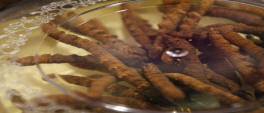A Journey Through Time
There are many Chinese legends and myths out there about the characteristics and power of the Caterpillar Fungus. However, it seems to be consistently known that it was first discovered in China, most likely around 620 AD. It has been used in traditional Chinese medicines as a source to cure everything from cancer to sexual dysfunctions in both male and females. It was used in ancient China in the Emperor's place for strengthening the body, aches, and illnesses. A few hundred years later, higher Chinese beauties used it as an ingredient in a fountain of youth to limit aging characteristics of their bodies. For quite some time they thought that this fungus was really a worm, because it simply resembled the shape of one. However, years of study proved otherwise. Either way, it is believed to have been used since a thousand years ago by either being ground into a powder or mixed.
Today, many of the modern drugs are purified versions of the chemicals found in those traditionally used medicines. It seems to be quite the herb considering there are many links and pages found online that lead to ways to purchase it. Since Caterpillar Fungus is found at such high altitudes, it is quite rare but fairly expensive. In fact, the price increases regularly recently hitting $53 dollars a pound with a consistent inflation rate from 100-300%. Check out this site where it is actually advertising to sell it online!
 This
is a picture of a store in Tibet that sells Caterpillar Fungus, which seems
to have an endless demand in the area.
This
is a picture of a store in Tibet that sells Caterpillar Fungus, which seems
to have an endless demand in the area.
Some people believe it cures coughing, anemia, back and knee pains while increasing strength even after a long injury. It contains all of the essential amino acids and is also known to be used for fatigue, cancer treatment, kidney enhancement, respiratory treatment, heartbeat stabilizer, cholesterol reduction, HIV infection treatment in Africa, cholesterol stabilizer, and many other vital life symptoms. Other in depth information on the benefits can be found here.
Keep trucking to learn about its
Nutrition&&Interactions!
![]() Habitat&&Adaptations page!
Habitat&&Adaptations page!
